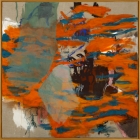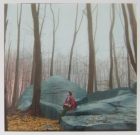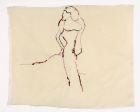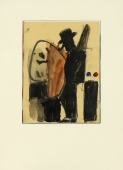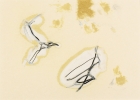
Artist | Richard Artschwager (1923 - 2013)
https://www.artist-info.com/artist/Richard-Artschwager
Biography
Biography
born in 1923 in Washington D. C., now lives in Brooklyn
About the work (english / deutsch)
About the work (english / deutsch)
In General
Artschwager is both sculptor and painter, and he has been developing both areas alongside each other since 1962. Furniture-like structures emerge via functional associations, yet their sculptural autonomy is never cast into question. He developed his style of painting using fiberboard, the surface of which had a coarse grain. In the 1960s and 1970s he produced exclusively gray paintings. The haptic qualities of the fiberboard stem from the radar screen which Artschwager scanned while serving in the military during the end of the Rundstedt Offensive.
Allgemeines
Artschwager ist Bildhauer und Maler. Beide Bereiche entwickelt er ab 1962 parallel. Über funktionale Assoziationen entstehen möbelähnliche Gebilde, deren skulpturale Autonomie jedoch nie in Frage gestellt wird. Die Malerei entwickelte er mittels einer Hartfaserplatte, deren Oberfläche eine grobe Struktur aufweist. In den 60er und 70er Jahren entstehen ausschließlich graue Bilder. Die haptische Hartfaserplatte hat ihren Ursprung im Radarschirm, an dem Artschwager am Ende der Rundstedtoffensive seinen Dienst verbrachte.
Während die Skulpturen über viele Zeichnungen, Schritt für Schritt, entwickelt werden, ist das Spektrum der Bilder schier unendlich.
Text von Jean-Christophe Ammann / Translation by Jeremy Gaines
(Extract - Full printed version available in the Museum)
(Auszug - Der vollständige Text ist als Informationsblatt beim Museum erhältlich)
MMK - Museum für Moderne Kunst, Frankfurt am Main
About the work (english): Book II / Chair Table
About the work (english): Book II / Chair Table
Book II (Nike)
Rendering the seemingly accessible inaccessible continues to occupy Artschwager. In Book III (Laocoön) of 1981 (Pl. 95 of the Whitney Exhibition Catalogue), a chunky prie-dieu offers comfort in a kneeling position, but the slant of the formica prayer-book holderand the hefty metal handles on either side of the inset "book" oblige a bowing motion that goes beyond customary practice. Although ostensibly somewhat familiar, the distorted form of Book III removes it from common experlence. Its implied activation seems logical at first glance, but on closer inspection becomes absurd. The purest and least distorted activity in this series of sculptures that serve as narrative locales is Book II (Nike), also of 1981 (Pl. 94, Whitney Exhibition Catalogue). In this piece, a V-shaped lectern holds the open white page of a formica book easily reached by ascending a short step. By title and in the implied action, Artschwager both likens the work to the ancient statue that graces the Louvre’s main staircase and encourages our kinesthetic response.
Chair Table
The Alice-in-Wonderland scale inversions and wildly imaginative combinations and placement of the six objects in the drawings and, by extension, in Pyramid, revived Artschwager's unfinished "blp" business. Inventing spaces to contain the six objects led naturally to a reconsideration of the question of context. At the Clocktower in 1978 he had reintroduced, for one final time, that para-punctuation into his imagery. He had also manufactured an edition of black, inverted commas about this time that, when installed, had the effect of labeling their environs "so-called". The conjunction of these linguistic signs with his furniture-portraits strongly suggests an unpopulated narration. Chair Table (1980; Pl. 87 of the Whitney Exhibition Catalogue), for instance, is another version of Artschwager's by now familiar duo - this time made bulky and officiallooking by its institutional oak-grain formica. A heavy-duty metal handle on the drawer recalls the first appearance of this implement in Handle (1962; Pl. 1, Whitney Exhibition Catalogue). His bemused attitude toward the enterprise of art, an attitude that previously confined itself to some witty titles and an array of somewhat preposterous images, now takes the form of a 3-foot-high exclamation point suspended over the tabte. For once, an implied spoken reaction is given real form.
Text by Richard Armstrong
(Extract of the Whitney Museum Exhibition Catalogue, 1988)
About the work (english / deutsch)
About the work (english / deutsch)
Description of Table / The Bush / Organ of Cause and Effect III
The demonstration of artificiality
The objects and pictures Richard Artschwager produced as of 1962 are autonomous works, each creating a specific world of its own. Mostly, the objects' shapes are derived from fumiture and paraphrase completely differing aspects of fumiture. Here, Artschwager formulates a balancing act between the functional everyday object and the artistic object, the pseudo-functionality of which only becomes apparent after a second glance. Over and above this, by means of a ‘demonstration ofartificiality’ in the material and aesthetic domain, Artschwager emphasized not only ambivalence, but also the reciprocal influence of object and art object as well as the domains of art and life in the present. His works with the titles Description of Table (1964), Construction with Indentation (1966) and Organ of Cause and Effect III (1986), which are respectively wooden structures, veneered with grained plastic mostly Formica - can neither clearly be attributed to some functional concrete realm nor to that of aesthetic production. Here, Artschwager creates structures that are identical only with themselves and refer only to themselves, located for the viewer in some interim zone between art and life. The closed box lying on the floor entitled Description of Table, which outlined the sections ofa table, marked in brown, and a white imitation table cloth, is not some real, usable table. Instead, the object presents itself as a structure reduced to its stereometrical, minimalist basis, functioning like an early paraphrase on Minimal Art. What is involved, as the title indicates, is the description of a table.
Construction with Indentation is an anonymous wallmounted object, a flat veneered wooden box with a rectangular and apparently inward indentation on the top, which seems to indicate that the work has a function. However, in our eyes the object remains what it is, even if we explore it from all possible sides. It is, what it is.
Organ of Cause and Effect III is an organ - given a stylized shape and made using the same materials. Artschwager reduced the instrument on which it is modeled to its key formal properties, the organ pipes which create a picture in our minds of a 'body of spatial sound’, then enlarging this to form a voluminous edifice that also attests to silence.
The two pictures with gray oils on coarse formica panels entitled One of Them (1967) and The Bush (1971) both reveal a subtly subverted realism that transposes a descriptive and demonstrative objectivity into painting. Owing to the fact that the coarse underlying panels are made of Celotex, and given that grisaille is used, the impression the paintings exude is that of enlarged and coarse-grained photography. Our view seems to feel its way forward through the lens of a magnifying glass or a microscope to reach the objects of perception, to delve ever deeper into the pictorial worlds of the photographs on which the paintings are modeled in order to uncover the core truth of things. If one considers The Bush the scene of an idyllic interior which Artschwager uses to point to our everyday private surroundings, a closer scrutiny of One of Them reveals microscopically small cellular structures enlarged a thousand times that refer us to the philosophical issue of the one and the many or the social issue of the individual and community. Artschwager is primarily interested in exploring the way things appear to us and to show us the reality in which they exist and their reality as phenomena we perceive. He endeavors to give us a keener perception of things. Like Claes Oldenburg he does so in the domain of object art. And he presents things and at times tries to influence them such that we more consciously experience reality, owing to the specific intrinsic life and the special 'intellectual' reality of his objects.
Description of Table / The Bush / Organ of Cause and Effect III
Die Demonstration von Künstlichkeit
Die seit 1962 entstandenen Objektgestaltungen Richard Artschwagers gehen auf Möbel oder Alltagsgegenstände zurück und bewegen sich in einer Gratwanderung zwischen dem funktionalen Alltagsgegenstand und dem erst auf den zweiten Blick erkennbaren pseudofunktionalen künstlerischen Objekt. Darüber hinaus verweist der Künstler mit Hilfe einer Demonstration von Künstlichkeit' im materialen und ästhetischen Bereich auf die Ambivalenz, aber auch auf die wechselwirksame Beeinflussung von Gegenstand und Kunstobjekt, von den Bereichen Kunst und Leben in der heutigen Zeit. Seine Objektgestaltungen mit den Titeln Description of Table (1964), Construction with Indentation (1966) und Organ of Cause and Effect III (1986), die jeweils aus Holzkonstruktionen bestehen, welche mit gemasertem Kunststoff - meist Resopal - furniert wurden, sind weder eindeutig in den Bereich der funktionalen Gegenständlichkeit, noch in den ästhetischer Gebilde einzuordnen. Artschwager formulierte hier vielmehr allein mit sich selbst identische und nur auf sich selbst verweisende Gestaltungen, die in einem Zwischenbereich zwischen Kunst und Leben angesiedelt sind und vor allem auf die Idee der Dinge verweisen. Der auf dem Boden liegende geschlossene Kasten von Description of Table, der durch braun abgesetzte Partien und eine weiße Tischdeckenimitation einen Tisch umschreibt, ist nicht etwa ein realer, benutzbarer Tisch, sondern präsentiert sich als ein auf eine stereometrische Grundform reduziertes, minimalistisches Gebilde, das wie eine frühe Paraphrase auf die Gestaltungen der Minimal-Künstler wirkt. Es handelt sich, wie im Titel angegeben, um die Beschreibung eines Tisches und damit um die konkrete, räumliche Vorstellung eines Gegenstandes an sich, ohne daß er gleichzeitig als ein Gebrauchsgegenstand erkennbar und einsetzbar wäre.
Construction with Indentation ist ein anonymes Wandobjekt, ein flacher, furnierter Holzkasten mit einer im oberen Teil rechteckig und perspektivisch nach innen gehenden Vertiefung, die dem Werk scheinbar eine Funktion zuweist. Das Objekt bleibt in unseren Augen jedoch was es ist, auch wenn man es nach allen möglichen Seiten hin untersucht. Es ist, was es ist.
Organ of cause and Effect III ist die stilisierte und in den gleichen Materialien ausgeführte Vorstellung einer Orgel. Artschwager reduzierte das instrumentale Vorbild auf seine wesentlichsten formalen Eigenschaften, die Orgelpfeifen, die sich in unsere Erinnerung als ‘Körper räumlicher Klänge’ eingeprägt haben und vergrößerte diese zu einem voluminösen, wenn auch Stille dokumentierenden Gebilde.
Die beiden mit grauer Ölfarbe auf grobkörnige Resopalplatten gemalten Bilder mit den Titeln One of Them (1967) und The Bush (1971) zeigen in einem subtil verfremdeten Realismus die Übertragung einer deskriptiven und demonstrativen Gegenständlichkeit in die Malerei. Dabei entsteht aufgrund der aus Celotex gearbeiteten, rauhen Grundplatte in Verbindung mit der in Grisailletechnik ausgeführten Ölmalerei stets der Eindruck einer vergrößerten und aufgerasterten Fotografie. Der Blick des Betrachters scheint sich durch die Linsen eines Vergrößerungsglases oder Mikroskops zu den Gegenständen der Wahrnehmung vorzutasten, immer tiefer in die Bildweiten, der als Vorlagen benutzten Fotografien einzutauchen, um dem Kern der Wahrheit der Dinge auf den Grund zu gehen. Sieht man in The Bush eine idyllische Interieurszene, mit der Artschwager auf das alltägliche private Umfeld des Menschen hinweist, so erkennt man bei genauerer Betrachtung in One of Them mikroskopisch kleine Zellstrukturen in tausendfacher Vergrößerung, die uns auf die philosophische Frage des Einzelnen und der Vielen oder auf die gesellschaftliche Frage des Individuums und der Gemeinschaft hinfuhren.
Artschwager geht es vorrangig darum, die Erscheinungsweise von Dingen zu ergründen, uns ihre Daseinsrealität und Erscheinungsrealität vor Augen zu führen. Er versucht, mit anderen Mitteln, aber ebenfalls im Bereich der Objektkunst wie Claes Oldenburg, unsere Wahrnehmung der Dinge zu schärfen, sie zu präzisieren und teilweise so zu beeinflussen, daß wir die Realität - bedingt durch das spezifische Eigenleben und die andere ‘geistige’ Wirklichkeit seiner Objekte - bewußter erfahren.
German text by Rolf Lauter / Translation by Jeremy Gaines
(Extract - Full printed version available in the Museum)
MMK - Museum für Moderne Kunst, Frankfurt am Main
Bibliography
Bibliography
Armstrong, Richard, Artschwager, Richard; Exhibition Catalogue of the Whitney Museum of American Art, New York, in association with W.W.Norton & Company, New York, London, 1988, ISBN 0-87427-057-X (Whitney paper), ISBN 3-393-30551-1 (Norton paper), ISBN 0-393-02596-9 (Norton cloth)
 offers / Requests offers / Requests  |
Learn more about this service |
|---|
 Exhibition Announcements Exhibition Announcements  |
About this service |
|---|
 Visualization |
Learn more about this service | ||
|---|---|---|---|

Interested in discovering more of this artist's networks?
3 easy steps: Register, buy a package for a visualization, select the artist.
See examples how visualization looks like for an artist, a curator, or an exhibition place: Gallery, museum, non-profit place, or collector.

Exhibition History

|
SUMMARY based on artist-info records. More details and Visualizing Art Networks on demand. Venue types: Gallery / Museum / Non-Profit / Collector |
||||||||||||
| Exhibitions in artist-info | 277 (S 68/ G 209) |
Did show together with - Top 5 of 2689 artists (no. of shows) - all shows - Top 100
|
||||||||||
| Exhibitions by type | 277: 142 / 74 / 57 / 4 | |||||||||||
| Venues by type | 167: 70 / 53 / 40 / 4 | |||||||||||
| Curators | 100 | |||||||||||
| artist-info records | Feb 1964 - Nov 2024 | |||||||||||
|
Countries - Top 5 of 13 United States (142) Germany (74) Switzerland (13) United Kingdom (8) Belgium (5) |
Cities - Top 5 of 68 New York (117) Berlin (14) Frankfurt am Main (14) München (9) Köln (9) |
Venues (no. of shows )
Top 5 of 167
|
||||||||||
Curators (no. of shows)
Top 5 of 100
|

I love America and America loves me |
||||||
| Galerie Bärbel Grässlin | G | Nov 2024 - Nov 2024 | Frankfurt am Main | (202) | +0 | |

The World on Paper |
||||||
| PalaisPopulaire | G | Sep 2018 - Jan 2019 | Berlin | (2) | +0 | |
| Hütte, Friedhelm (Curator) | +0 | |||||

Art and Alphabet |
||||||
| Hamburger Kunsthalle | G | Jul 2017 - Oct 2017 | Hamburg | (198) | +0 | |

Primary Structures - Meisterwerke der Minimal Art |
||||||
| Tower - MMK | G | Feb 2017 - May 2017 | Frankfurt am Main | (10) | +0 | |
| Kramer, Mario (Curator) | +0 | |||||

Forty |
||||||
| MoMA PS1 | G | Jun 2016 - Aug 2016 | Long Island City | (320) | +0 | |
| Heiss, Alanna (Curator) | +0 | |||||

The Sonnabend Collection - Half a Century of American and European Art. Part I |
||||||
| Fundação de Serralves | G | Feb 2016 - May 2016 | Porto | (22) | +0 | |
| Homem, Antonio (Curator) | +0 | |||||
| Braga, Isabel Sousa (Curator) | +0 | |||||
| Keep reading |



















